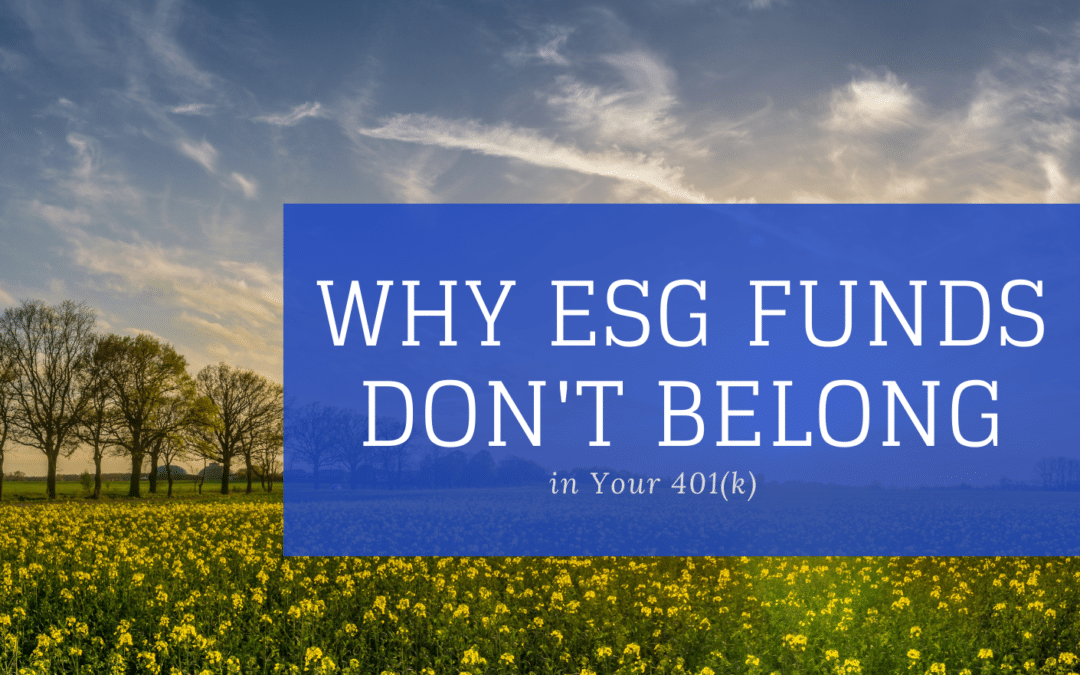As interest grows in environmental, social and governance (or ESG) investing, a lot of people may wonder why their 401(k) plan does not offer ESG funds. I’ve even noticed some smart financial thinkers suggest that people should lobby their employers to add ESG funds to 401(k) lineups.
At first glance, the logic is there. For many investors, the savings in their 401(k) accounts may be the bulk of their wealth, and they want to invest in a way that reflects their values. Plus, there’s a growing body of research that shows companies doing a good job of addressing ESG issues in their business tend to outperform companies that are doing a poor job on ESG.
Yet for all the good reasons to pursue an ESG investment strategy, I don’t think 401(k)s are the place for ESG funds.
Let me explain. A workplace retirement plan is designed for a diverse group of participants, which creates variables that don’t exist when constructing a portfolio for an individual or family. Above all else, these plans should help people invest while minimizing the chance for mistakes–and that’s what I believe is the core problem with introducing ESG options.
There is plenty of evidence that adding more fund choices to a plan increases the likelihood of investing blunders.
Common Mistakes People Make in Their 401(k) Could Be Amplified by Including Additional Funds
One of the most common errors is straight-up performance chasing. Despite the common warning that “past performance is no guarantee of future results,” many 401(k) investors change their investment mix every year, dumping lagging funds while investing in the ones with the biggest returns last year. Of course, doing so locks in relative underperformance or losses from funds that are temporarily down. This leaves investors expecting big gains that may not materialize.
The tendency for investors to chase performance must be considered when introducing ESG funds to a 401(k) today because these outperformed simple index funds during the last one-, three- and five-year periods (periods of performance that often accompany funds options for 401(k) plan participants).
False diversification is another potential mistake people make. With more funds to choose from, you might decide to invest in nearly all of them–thinking that more funds means your portfolio is even more diversified. What people often don’t realize, though, is that they’ve selected multiple funds that invest in essentially the same way. Adding an ESG fund to your plan may not help you diversify your overall portfolio at all, particularly if participants lack a basic understanding of asset allocation (as many do in my experience).
Finally, there’s the biggest mistake of all: Simply not participating. Choice overload is a real thing in retirement plans. This happens when it feels too complicated to pick among a broad selection of funds, so some people decide not to bother at all. Whenever a plan’s trustees add fund options, the chances that some investors will decide to just give up entirely increase. This concern applies to funds of all types, not just ESG-focused offerings. Research suggests participation in 401(k) plans is higher in plans offering a handful of options as opposed to 10 or more funds. Without eliminating other fund options, adding ESG funds to a menu of choices is only likely to exacerbate the problem of too much choice.
Other Ways to Fulfill Your ESG Investment Objectives
If you’re concerned about addressing ESG issues, you might take some comfort in the fact that most fund providers for corporate retirement plans are already standing up for ESG causes. Vanguard Group and BlackRock, for example, are significant shareholders at many of the companies they invest in—and they take that responsibility seriously. They vote their shares in a way that upholds many of the ESG principles investors care about.
There are also other ways individual investors can make a difference, beyond using ESG funds in an employer-sponsored retirement plan. In some cases, these strategies might even give you more direct involvement in the causes that matter to you.
Use your money to advance ESG issues outside of your retirement plan. You can invest in ESG funds outside of your 401(k). A financial advisor can help you ensure that your ESG allocation aligns with your goals and investment strategy. Alternatively, save diligently and build enough wealth to give directly to the organizations focused on issues you care most about.
Take an active ownership approach. Buy a single share of stock in the company or companies you dislike most from an ESG perspective, then go to their shareholder meetings and speak your mind during Q&A on the open microphone. Attending a shareholder meeting might require you to buy a plane ticket, book a hotel room, and even take time off work – which could be a significant investment and clearly not realistic for everyone – but it’s one way to make your voice heard.
Give your time and talent. This is an often-overlooked way to contribute, but it can be a powerful one. You might start by identifying policies in place with your own employer that you’d like to see changed, and then addressing those with the company’s management. Maybe that means leading a team that makes recommendations on establishing a more equitable parental leave policy, reducing the company’s carbon footprint, or increasing diversity in the workplace. Or, if there’s a community organization you’d like to support, but your financial resources are limited, think about other ways you could contribute such as volunteering on weekends or taking on a role with the board.
There are plenty of compelling reasons to be interested in ESG investing. However, a workplace retirement plan comes with a unique mandate and set of concerns that can make ESG funds a poor fit for that specific investment vehicle.
That doesn’t mean that you have to take ESG causes off the table entirely. There are other ways to invest and affect change to causes that are important to you – and some of those methods may provide you the added benefit of seeing the impact first-hand.
Next Steps
Want to hear more about my thoughts on Environmental, Social and Governance (ESG) investing?
You may enjoy these articles: What Does it Mean to Be an ESG Investor? and 6 Methods to Consider When Choosing an ESG Investing Strategy.
If you want to delegate your ESG investment strategy and other financial decisions to a professional, here are ways I can help you.
…
RESOURCE: Do you want to make smart decisions with your money? Discover your biggest opportunities in just 9 questions with my Financial Wellness Assessment.















